Fabrics set the stage for manufacturers who want a market share of the entertainment industry.
Fabrics don’t get enough credit.
Quietly, and usually without fanfare, they provide welcome and shelter as tents and awnings; they enhance decor and create distinct spaces as backdrops and banners; they manage movement of light and sound; and the list goes on. When it comes to the world of entertainment—whether for television, film or theater—fabrics are instrumental in setting the scene, providing comfort and even creating illusion.
Swift turnarounds
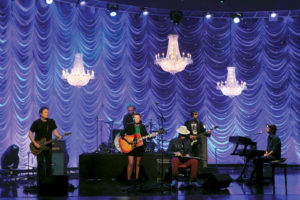
Alpha Tent & Awning Ltd., in the heart of Vancouver, British Columbia, Canada’s film production district, provides fabric products including tents, awnings, canopies and upholstery for the film and television industry, and identifies the film sector as being its most rapidly growing and profitable market. The company’s varied work includes projects such as designing and installing period tents using buffalo hides, Chinese hemp and driftwood for the movie 13th Warrior and upholstering a spaceship and space station interior for the movie Mission to Mars.
Providing work in a tight timeframe is critical to gaining jobs in film and television. “We’ve been working for different film and television companies for more than two decades and will continue to do so,” says Vlad Cohen, M.Sc., P.M.P, C.S.M, president of Alpha Tent & Awning. “Film and TV requests have to be completed immediately or within 48 hours.”
Paul Grider, director of product development and technical services for Sun Valley, Calif.-based Dazian Creative Fabric Environments, agrees. “We supply traditional textiles for the industry such as velour, meshes and scrims, muslin, duvetyn, light diffusion and projection fabrics, as well as decorative fabrics used in set designs,” he says. “Television and film typically work very quickly with very short lead time to get what is needed. Decisions are made quickly, as production times are strategically planned with little to no time for delays, unlike architectural, exhibit or commercial projects where the design process and decision making can take months or years to get finalized.”
A past present
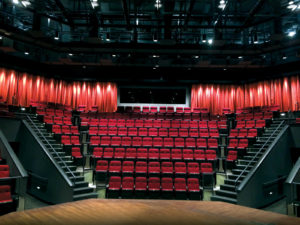
space that also controls acoustics.
Photo: iWeiss Theatrical Solutions.
Tents and awnings are used to turn back the clock on television and movie sets. Capitol Awning, Jamaica, N.Y., is currently working on a Woody Allen movie that takes place on Coney Island in the 1950s. The company is making a total of six awnings for four sites for the film. At one site, all that’s needed is to cover existing backlit awnings using period-correct colors. “In those cases we’re essentially making fabric bags to set right over the top of the backlit awnings,” says Mike Catalano, Capitol Awning’s CEO. “And sometimes the existing awnings might not be in the shot but when the crew plans their camera angles, they might notice something in the background that’s, say, DayGlo orange. In those cases we don’t need to build a frame; we just put fabric over the top and literally attach it with Velcro®. We don’t even need to do the installation; the film crew takes care of that.”
At another location for the same film, Capitol is taking a doughnut shop awning that comes out two feet and covering it with a separate awning that extends to 12 feet to make the shop look like a fruit stand from the period. The biggest challenge when creating period work is getting fabrics that suit the era, Catalano says. “There are times I’ve had to overnight the fabric from California to get what I need in time,” he says. “The client pays dearly for that kind of service, however.”
Ed Burak, president of Hudson Awning & Sign Co., Bayonne, N.J., has worked on a myriad of productions including The Nick series, The Wolf of Wall Street and The Producers, to name a few. He says his company’s records go back to the early 1900s and that it has several kinds of fabric no longer available anywhere else. But when shots call for original fabric that the company doesn’t have on hand, Burak looks to other awning shops or makes it in-house. “For instance, if the movie or television show calls for a canvas that’s painted gray on one side—very little of that exists any longer,” he says. “We end up making the design and striping it so it conforms to what they want.”
Special effects
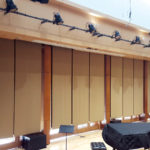
When it comes to backdrops and scenery, digital printing is being utilized more and more often for its high-resolution image capturing, customization capabilities and quick turnaround times. “Projection fabrics are also on the rise in live television and stage production, as production designers and art directors implement what we call ‘technical scenery’ into their shows,” Grider says. “These technical fabrics can create visual effects either through projection or lighting techniques. As technology advancements in stage lighting and projection equipment continue to grow, we’ll see more and more fabric being used.”
Fairview, N.J.-based iWeiss Theatrical Solutions provides a wide range of fabric solutions for theatrical work such as Cirque du Soleil in Las Vegas and New York City, New York public school stages, church productions and theater renovations. “There are so many uses for theatrical fabrics,” says Jennifer Tankleff, iWeiss Theatrical Solutions president. “You can’t really envision all the ways you can use a fabric until you start sampling with it.”
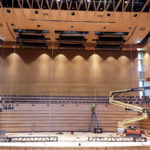 Take, for example, the project Tankleff and her crew are doing for a church in Michigan that is doing a Kabuki SP reveal of aerialists at a church production. They’re using theatrical scrim to create a column where the aerialist will be inside, and using a lighting technique to keep the aerialist concealed until the stage lights go on. Then the scrim will drop like a Kabuki System, revealing the aerialist. “I never would have assumed scrim would be the best choice for this but once we started developing the concept, we saw that it works well because of its lighting components,” Tankleff says.
Take, for example, the project Tankleff and her crew are doing for a church in Michigan that is doing a Kabuki SP reveal of aerialists at a church production. They’re using theatrical scrim to create a column where the aerialist will be inside, and using a lighting technique to keep the aerialist concealed until the stage lights go on. Then the scrim will drop like a Kabuki System, revealing the aerialist. “I never would have assumed scrim would be the best choice for this but once we started developing the concept, we saw that it works well because of its lighting components,” Tankleff says.
Hear ye, hear ye
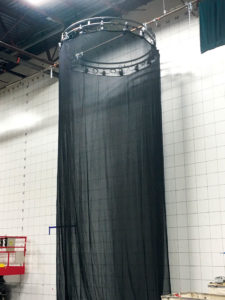
Acoustic concerns and theater spaces go hand in hand, and iWeiss Theatrical Solutions is often called on to make acoustic banners to improve the way sound plays in a room. The company is currently building an acoustic banner for Liberty University in Lynchburg, Va. “This will be one of the largest acoustic banners yet for the theater industry,” Tankleff says. “It will be used as a projection surface as well as an acoustical element. It will be installed in front of windows and can be taken out and put back in depending on the acoustical needs of the event.”
To make the banner, Tankleff and her team are using wool serge—a material typically available in black for use as masking. “Our industry has begun using it for acoustics,” she says. “We had it independently tested to see how it changes the acoustics. And we’re custom-dyeing colors so the banners match the architecture of the space.”
Safety first
Code considerations differ depending on the venue, location and how the fabric is being used. Fabric installations for theaters, in particular, are strictly regulated. “Of course it’s critical that fabrics be flame retardant (FR) for anything in public assembly,” Tankleff says. “Almost everything we do is FR.”
Grider cites California’s Title 19 fire safety standards and NFPA 701 (which applies to textile materials used in interior furnishing for public occupancy buildings) as the two certifications required for fabrics used on sets and stages. “Safety requirements and enforcements from insurance companies and fire marshals get tougher every year—and for good reasons,” Grider says. “The safety of the crew and those on set is top priority and our customers have embraced these changing guidelines because the last thing you want is your show to get shut down because you are using subpar fabric.”
It’s who you know
When it comes to securing work in the entertainment industry, perhaps the best advice—besides “do quality work and be able to hit short deadlines”—is to build relationships with set directors and artistic directors. And work on television series can automatically mean ongoing projects. “Television shows have seasons that can run for years, resulting in a lot of repeat business,” Grider says.
His advice for preparing for future work with the client is to ask questions. “Maintaining dialogue off set is vital to forecasting your role for next season,” he says. “We use time during hiatus to probe our television clients on what the next season may bring. Are there going to be any design changes? Is there a change in the show that may result in less business due to location changes? Are they planning on changing or updating any scenery?”
Even considering the short turnaround times and intense workload during that time, these manufacturers agree that fabric applications for the entertainment industry are a lucrative and rewarding market segment. “Our first project for the entertainment industry was for the movie The War of the Worlds in 2005,” Burak says. “We did a one-door aluminum awning. It was a little thing, but I got to know the set directors and before I knew it I was working on all their projects.”
Everything new is old again
To create awnings that look aged to suit the needs of the director, Hudson Awning & Sign Co., Bayonne, N.J., gets the whole staff involved. “We do most of the aging here by using different techniques to make them look ratty,” says Ed Burak, Hudson Awning & Sign Co.’s president. “We use a lot of dirty feet—including putting the awnings down in the welding shop to let everyone who goes through there walk over them.” The crew also washes the awnings in a large washing machine to take away the newness and create a wrinkled product, degrades them with chains and sandpaper, and sews the products using too much fabric to create a droopy effect.
For some applications, the requirement is for the same awning to appear in different years. For the HBO series Boardwalk Empire, Hudson Awning & Sign Co. created awnings for building facades two and five years out in addition to the original awning. “It’s fun to see what you can do to vary each facade just the right amount,” Burak says.
 TEXTILES.ORG
TEXTILES.ORG


